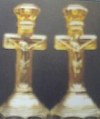US Glass - Part 3
U.S. GLASS - Part 3
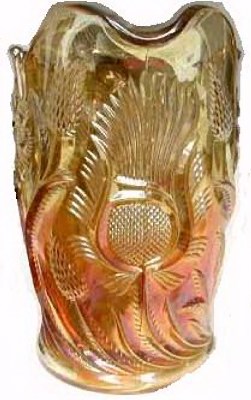
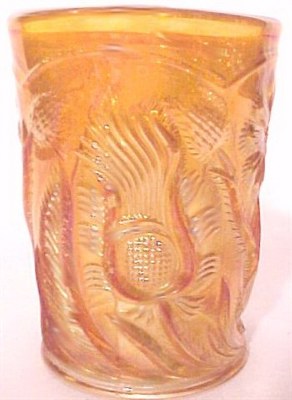
Left - FIELD THISTLE Water pitcher. Right - FIELD THISTLE Tumbler.
FIELD THISTLE Water set: Marigold or what is better described as honey amber is the only color found in this pattern. In addition to the pitcher and tumbler, a table set -( covered butter, sugar, creamer and spooner), and plates of two sizes are known in the pattern. They should all be considered very scarce to rare. It will take some persistence to attain any of the pieces listed here. A tumbler such as the one shown sold at the Collier auction in Feb. of 1976 for $225! That was a large piece of change in those days! On the other hand, a very nice water pitcher, though pale in color brought $55 during the Nov. 13 Wroda sale in Greenville, OH. Far more rare than any water set from Northwood or Fenton , that pitcher is easily worth more than three or four hundred dollars! Given its scarcity, it's possible that only about half the room full of auction attendees had ever seen one before?
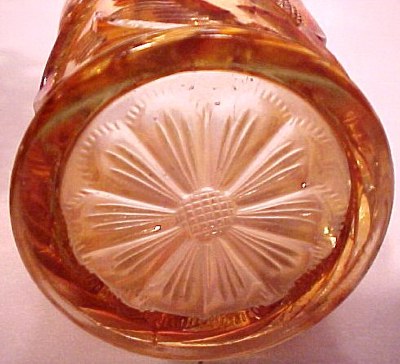
Base of FIELD THISTLE Tumbler: is complete with a lovely incised flower design within the marie. This is the mark of a fine piece of glass, and certainly not found on the average tumbler.
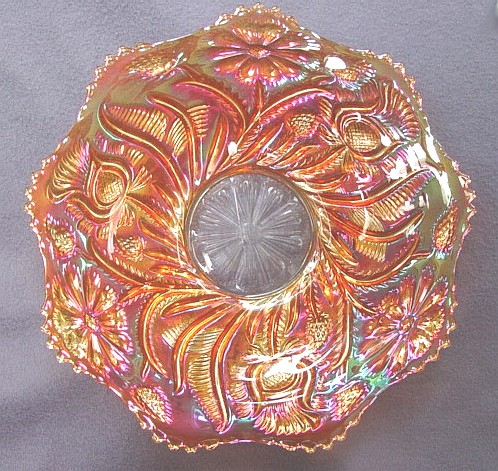
FIELD THISTLE Chop Plate: portrays the extremely artistic design on the exterior of this large plate, as well as on the smaller 6” size. The one shown here was purchased from the Jane and Bob Brown collection out of Texas, when Seeck Auctions sold their glass during a combined San Diego/Southern Ca. Club Convention in the early 90s. Few of either size plate are sold in any given year! The flower design within the marie adds considerably to the beauty of this large plate.
Note: Please see small FIELD THISTLE Plate displayed in the (6-7 inch DYNAMOS segment-this site).
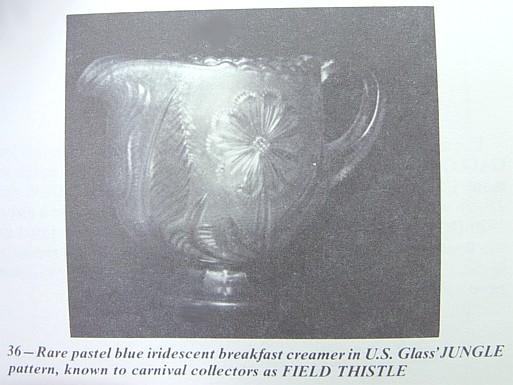
FIELD THISTLE Creamer: Research into Collecting Glass 2 by Wm. Heacock (1985), a wide asst. of carnival glass by the giant U.S.Glass Company was documented. Two particular rarities were brought to attention, both seen during Heacock's lecture tour in CA that year. Pictured here is a small breakfast-size creamer in a lovely shade of pastel blue, a color not known in U.S.Glass carnival. However, the firm did make a line of stretch glass in this shade of blue, so apparently this creamer dates from this later, circa 1920-1930 period. It does have a hint of stretch effect at the rim of the creamer's mouth. The original name for this pattern was JUNGLE, which was endorsed in another writing, but carnival collectors would be very confused (and rightfully so) if we tried to reinstate original manufacturers' names on their carnival table pattern lines.
- UPDATE -
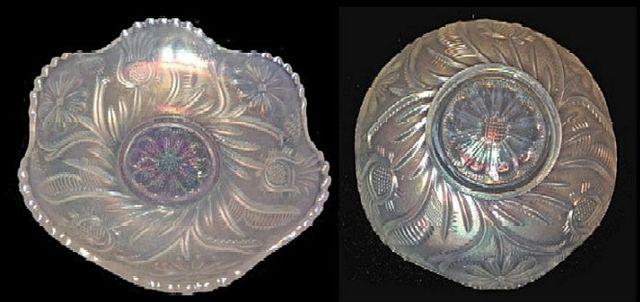
White FIELD THISTLE Bowl - 5.5 in. diam. Courtesy Gregory Ferguson.
UPDATE - This bowl sold for $256.00 on Ebay 01 - 21 - 2014.
Dec. 14, 2013, Greg Ferguson provided these photos of a recent “find” he is pleased to own! He says the Field Thistle 5 ½” bowl is nicely iridized on both sides.
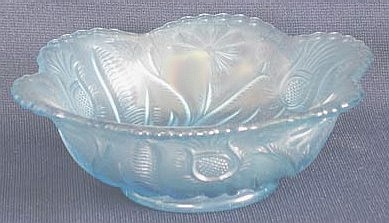
FIELD THISTLE 5 in. dish in celeste - type blue.This rarity brought $475 at the 2005 Seeck Sale for HOACGA.
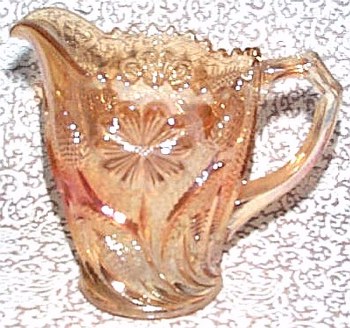
FIELD THISTLE 5” CREAMER: Evasive as these table pieces are, we are pleased to show you the creamer. Has anyone seen a sugar bowl?
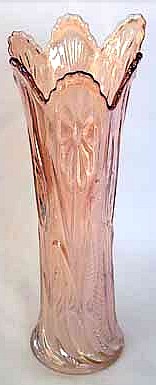
FIELD THISTLE VASE: A very rare specimen in this pattern! Seemingly, they were “swung” from the tumbler mold.
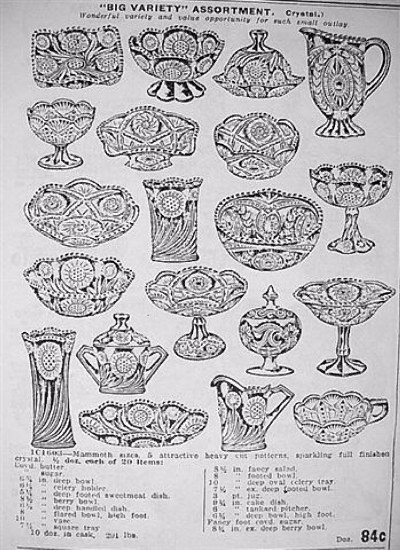
FIELD THISTLE CELERY HOLDER: was sold at auction in 1993, having extremely poor iridescence, listed as the only only one known, (called a vase in the brochure, and named “FEATHER SWIRL?”), actually appears to be the 6.25 inch celery holder seen in a Mid-Spring 1911 Butler Bros. It sold for $60.
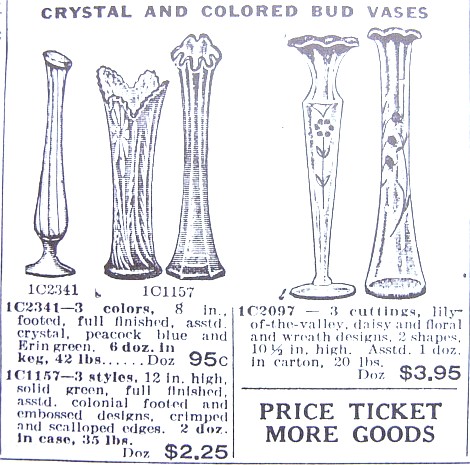
Field Thistle vases, as such, are verified by a 1927 Butler Brothers Wholesale Catalog Ad.
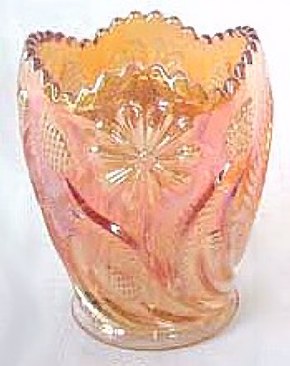
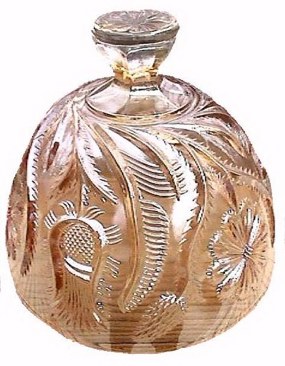
Left - FIELD THISTLE Spooner. Right - FIELD THISTLE Butter lid.
FIELD THISTLE SPOONER : This is the first example we have seen in the years we have been collecting. It was included in the Burns Auction glass which sold during the Nov. 2004 Michigan Bash Convention in Lansing, MI. Obscure pieces such as this provide an opportune moment to say once again: when an unusual and rare opportunity to purchase a virtually unheard of example (in any pattern) which has never received enough dialogue and notoriety to be recognized as such, the phrase, “a rare-so what?” comes into play! Virtually nothing has ever been scribed about U.S. Glass patterns, other than Palm Beach and Cosmos and Cane, so an auction crowd gives little or no notice to “that which is unheard of”.
This very rare spooner had some chips around the edge. SOOOOOOOOOOO? One or two of the Peoples' vases have cracks! Because a big noise has been raised about the vases over the years, buyers will pay thousands for the privilege. This sadly neglected spooner sold for the paltry sum of $5 ?? Shame on us!
FIELD THISTLE BUTTER DISH LID: offers evidence of the third piece in what must be a full size table set. In our years of search, we have never seen a complete table set. It certainly is something to be desired, and worth all the tea in China!
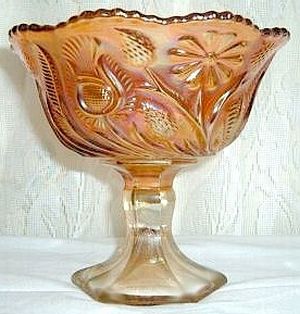
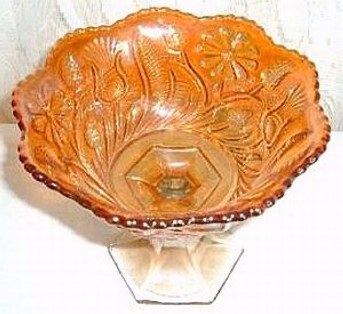
6.5 inch tall FIELD THISTLE Compote with an opening
span of 7.5 inches. A real rarity!
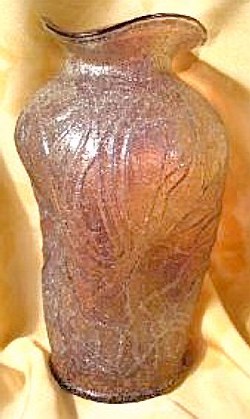
STIPPLED ESTATE Vase: The amethyst example shown here has all the characteristics of the carry-over design from the Dugan pre-carnival Venetian, Pompeian, and Oriental art glass period of production. These are mold-blown vases issued into iridescent production until newer, more updated patterns could be developed. Very few of this type vase surfaces today. Light green base glass, some marigold/peach opal and this amethyst/amber shade are seen on occasion.
Usually 3”-4” in height, this example stands 6 ¼” tall. They all have the triangular ruffled top, but since they are blown vases, the possibility of another top treatment could exist. Research indicates Dugan production to have been as early as 1905-1909.
However, we list the vase here within the U.S. Glass spectrum, in order to lend interest to the fact that the mold was originally owned by Model Flint Co., Albany, IN in 1900-1902, (one of the 19 Conglomerates), indicating their sale of this mold to Dugan Glass Co.
For more info please see:
Dean & Diane Fry - 01/05
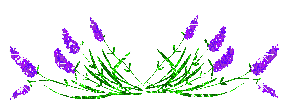
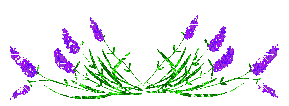

>INSIGHT<
Though the vast majority of the New Testament is written in common (koine) Greek, there are occasional words in Aramaic, the language of the Jewish people at that time. One such Aramaic word is Abba (Galatians 4:6). It is a tender term that could be translated “Daddy” or “Papa”. The wonder that we are allowed to call on God by this personal term (see Romans 8:15) is made more remarkable by the fact that Jesus used this name for God as He prayed in Gethsemane (Mark 14:36).



Should you care to contact the Frys, their email address is:
Search Our Sites
back to Carnival Glass 101
Our other sites you may enjoy:
Everything you EVER wanted to know about Indiana Glass
Great Reference for Newer Carnival Glass.
Complete Glassware Catalogs Available to Download
Questions? Comments? Suggestions? Broken Links? Corrections?
Your Friendly Webmaster is here to help!
